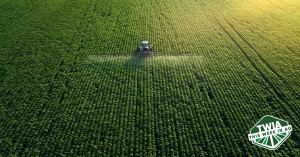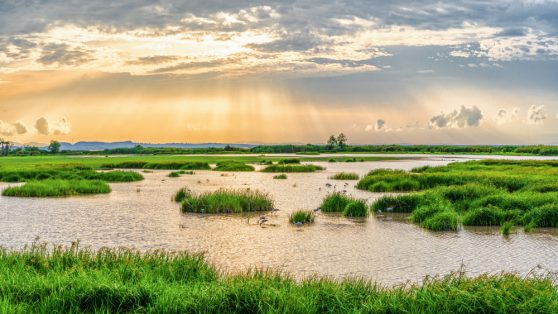By Jael Batty
Constructed wetlands, which mimic natural wetlands, treat municipal and industrial wastewater, mine drainage, small business and household greywater, animal wastes, and agricultural and stormwater runoff. They are recommended by regulatory agencies as a best management practice to control urban runoff.
Shallow Water Ecosystems
Constructed wetlands are shallow-water ecosystems that mimic natural wetlands. The wetland ecosystem—water, plants, microorganisms, sunlight, substrate, and air—filters and treats wastewater. Water quality is improved through physical, biological, and chemical processes, and the risk of pollution from runoff is reduced.1
Surface or subsurface water is present in both constructed and natural wetlands. Constructed wetlands are also called artificial wetlands, engineered wetlands, man-made wetlands, greywater wetlands, reed beds, soil infiltration beds, or treatment wetlands.
Pollutants and Pathogens Are Removed
Treatment through constructed wetlands removes pollutants, organic matter, metals, hydrocarbons, nitrogen, phosphorus. A variety of pathogens is also removed, although wetlands are not specifically designed to do so. In addition, high organic loads, as found in agricultural wastewater, can be reduced from wetland treated wastewater.2
Some wastewaters are treated exclusively by constructed wetlands. Generally, however, wastewater influent enters the wetland after primary treatment that separates solids from liquids. As such, wetlands serve as a secondary or tertiary treatment, sanitizing effluent prior to water reclamation.
 Wetland Construction
Wetland Construction
Wetlands are constructed inside a basin that is lined with plastic, concrete, or clay. The filter is a substrate of sand and gravel. The shallow depth, slow flow, and saturated substrates in wetlands encourages settling.2,3
Vegetation—such as bulrushes, reeds, cattails, and duckweed—is vital to the removal of metals and other pollutants. Heavy metal uptake varies among plants. Plant roots and rhizomes loosen substrate medium, increasing water movement through the rhizosphere. Water is channeled through holes in the substrate caused by decaying plant roots.2,4
The Treatment Process
Treatment occurs as wastewater flows through the substrate and the rhizosphere. The slow flow allows longer periods of contact between wastewater and wetland surfaces. A diverse community of aerobic and anaerobic microorganisms is attracted to the organic/inorganic materials and the opportunities for gas/water interchanges. Microorganisms attach to roots and rhizomes, forming a biofilm that breaks down pollutants and organic matter. Nutrients–carbon, nitrogen, and phosphorus–provided by plant litter and decomposing plants feed the microbial process. 2,4
In the substrate, suspended solids are filtered out of the wastewater and pathogens are removed by filtration and adsorption. The saturated substrate creates an oxygen-deprived environment in which oxygen is consumed more rapidly than it is replaced. This low-oxygen environment prevents the growth of plants unfit for a wetland environment.4
The low-oxygen environment is also essential to the elimination of pollutants. Nitrogen is broken down and nitrogen gas is released harmlessly into the atmosphere. Phosphorus is collected and stored within a wetland system by binding phosphorus in organic matter or by coprecipitation with iron, aluminum, and calcium. Likewise, heavy metals are sequestered in the substrate or absorbed by plants.2,4
Surface Flow and Subsurface Flow
The two types of constructed wetlands are surface flow or floating treatment wetlands, and subsurface flow or reedbed systems. Vegetation floats on the water in floating or surface flow wetlands. Surface flows are horizontally flowing, meaning wastewater flows parallel to the substrate.2,5
In subsurface wetlands, plants grow in gravel. Water may flow horizontally or vertically—in which case, wastewater moves down through plants and substrate. Whether vertical or horizontal, in a subsurface wetland, wastewater flows between plant roots and never surfaces.4,6
Water Reclamation
Discharged water is controlled by an outlet structure that allows seasonal and maintenance adjustments in water depth. Wetland-treated water may be stored for reclamation or land-application. Water may also be discharged to the water supply where allowed by regulations.7
Benefits and Disadvantages
Besides improving the quality of wastewater effluent, constructed wetlands cost less to build and power than conventional treatment. Furthermore, they are cheaper to operate and require fewer man-hours and less operational expertise. Ancillary benefits include providing wildlife habitats, recreational sites, and educational and research opportunities. Wetland construction also appeals to engineers, wastewater treatment operators, biologists, and environmentalists

- Improved water quality
- Water conservation and reuse
- Flood storage
- Attracting wildlife
- Habitats for fish and wildlife
- Low construction costs
- Low energy requirements
- Low operating costs
- Minimal operational attention and expertise
- Education and research
- Recreational opportunities for photographers, bird watchers, and hunters1,3
Some of the disadvantages include:
- Some complex pollutants cannot be successfully filtered
- Require more land
- Subsurface flows can clog
- Surface flows attract mosquitos,
- Surface flows are also susceptible to odor and algae2
The benefits far outweigh the disadvantages. In fact, many issues can be avoided by proper planning and operation. Fish and wildlife can reduce mosquitoes, and a canopy of wetland vegetation can prevent algae. Odor can be alleviated with primary treatment. Odor can also be prevented by maintaining a layer of gravel above the aquifer, controlling water levels, and thinning wetland plants to encourage water flow.6
Issues caused by clogged subsurface flows can be averted by avoiding the use of fine mediums in the substrate. Reducing organic overload, and practicing good wastewater pre-treatment also helps prevent clogs. Because there is no standing water in subsurface flow wetlands, they are odorless, don’t attract mosquitos, and are less susceptible to cold temperatures. Additionally, subsurface flow wetlands also occupy less area than surface flow wetlands and are better at the removal of pathogens.7
A Growing Trend
Constructed wetlands are used throughout the world to treat wastewater and runoff, improving water quality. They may also be used residentially, following primary septic tank treatment. Using constructed wetlands to treat greywater is a growing trend in water conservation. Finally, reclamation and reuse of wetland-treated water is a proactive step to solving the global water crisis.
For more information about wetland construction and regulations, see the EPA Constructed Wetlands page.
Citations:
- J Gelt (1997). Constructed Wetlands: Using Human Ingenuity, Natural Processes to Treat Water, Build Habitat, University of Arizona Water Resources Research Center,
https://wrrc.arizona.edu/publications/arroyo-newsletter/constructed-wetlands-using-human-ingenuity-natural-processes-treat-wa - Constructed Wetland, Wikipedia,
https://en.wikipedia.org/wiki/Constructed_wetland - Constructed Wetlands Factsheet, National Small Flows Clearinghouse,
https://engineering.purdue.edu/~frankenb/NU-prowd/cwetfact.htm - A Handbook of Constructed Wetlands, EPA,
https://www.epa.gov/sites/production/files/2015-10/documents/constructed-wetlands-handbook.pdf - (2000). Wastewater Technology Fact Sheet: Free Water Surface Wetlands, EPA,
https://www3.epa.gov/npdes/pubs/free_water_surface_wetlands.pdf - (2000). Wastewater Technology Fact Sheet: Wetlands: Subsurface Flow, EPA,
https://www3.epa.gov/npdes/pubs/wetlands-subsurface_flow.pdf - (2008). Constructed Wetland, NRCS,
https://www.nrcs.usda.gov/Internet/FSE_DOCUMENTS/nrcs143_014875.pdf
Related Posts

The Tradition of Easter Eggs: From Symbolism to Celebration
The Tradition of Easter Eggs: From Symbolism to Celebration Easter is not only a time for religious reflection, but also a celebration of the season's most iconic symbol: the egg. Did you know Americans purchase 180 million eggs just for Easter? Eggs have long been associated with new life, which makes them the perfect symbol for this holiday. The practice of gifting eggs dates back to early Christianity, when eggs were saved during Lent—a time when fasting meant meat could not be consumed. But eggs, easily preserved without refrigeration, were kept and often given to children on Easter, sometimes painted red to symbolize the blood of Christ. Today, we still celebrate with hard-boiled and decorated eggs, but modern Easter traditions also include the ever-popular chocolate eggs. In fact, over 91 billion chocolate eggs are sold for Easter each year! Another beloved tradition is the Easter Egg Roll, a fun and historic event symbolizing the rolling away of the stone from Christ’s tomb. The White House has hosted an official Egg Roll since 1878, and today, it continues to bring joy to thousands, thanks to the efforts of our First Ladies.

This Week in Ag #19
Rain makes grain. Those words are as old as farming itself. In the nation’s breadbasket – the three I states, which produce 42% of our corn and 37% of our soybeans – there’s concern over the lack of rain. That triggered a major movement in the grain market. Drought officially grips 100% of the I

This Week in Ag #83
Grandpa Fred never saw me. Despite the fact I was at his house nearly every day for over two decades. That’s because he was blind. From a farm accident. An anhydrous hose burst and shot the gas in his eyes.


 Wetland Construction
Wetland Construction